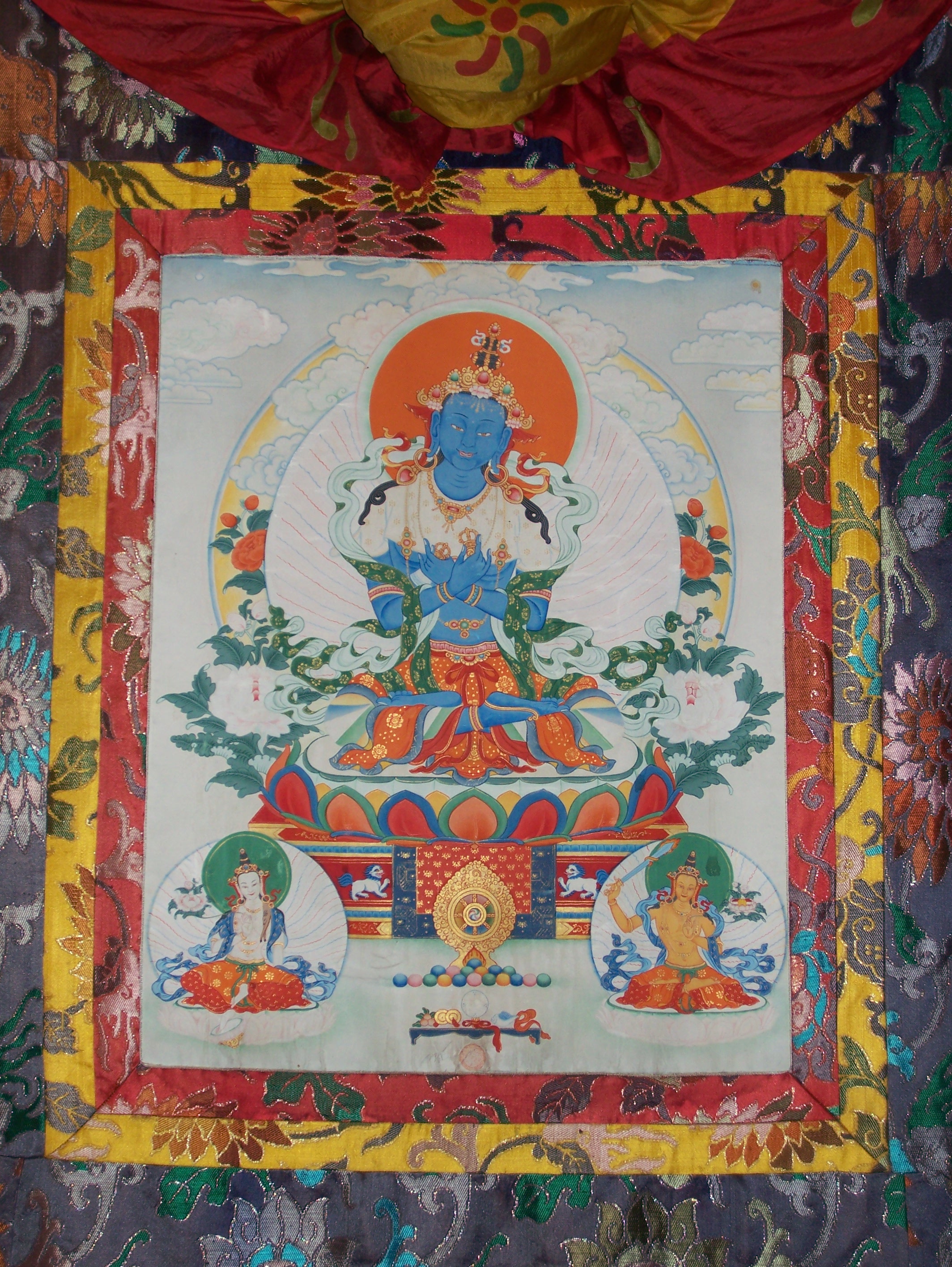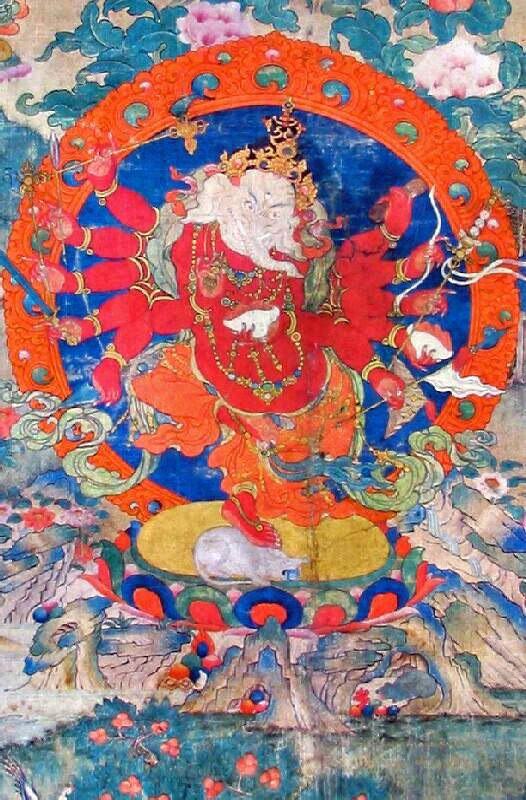|
Shining Relics Of Enlightened Body
Shining Relics of Enlightened Body () is numbered amongst the ' Seventeen Tantras of Menngagde' () within Dzogchen discourse and is part of the textual support for the Vima Nyingtik. Translation Though no other predating version from the Tibetan is likely nor extant, the work is held to be a translation in the Nyingma Dzogchen tradition though no originating language is made apparent in the secondary literature. Martin (1994: p. 282) holds that Vimalamitra was assigned to the translation group that was responsible for this work: "The work was translated and verified by the Indian Master Vimalamitra and the Tibetan translator Ka-ba Dpal-brtsegs." Ka-ba Dpal-brtsegs, important in the codification of the Tibetan Buddhist canon, is numbered as one of the 'twenty-five rincipaldisciples' (Wylie: rje 'bang nyer lnga) of Padmasambhava. Relics Sarira are generic terms for "Buddhist relics", although in common usage these terms usually refer to a kind of pearl or crystal-li ... [...More Info...] [...Related Items...] OR: [Wikipedia] [Google] [Baidu] |
Tibetan Script
The Tibetan script is a segmental writing system (''abugida'') of Brahmic scripts, Indic origin used to write certain Tibetic languages, including Lhasa Tibetan, Tibetan, Dzongkha, Sikkimese language, Sikkimese, Ladakhi language, Ladakhi, Jirel language, Jirel and Balti language, Balti. It has also been used for some non-Tibetic languages in close cultural contact with Tibet, such as Thakali language, Thakali. The printed form is called uchen script while the hand-written cursive form used in everyday writing is called umê script. This writing system is used across the Himalayas, and Tibet. The script is closely linked to a broad ethnic Tibetan identity, spanning across areas in India, Nepal, Bhutan and Tibet. The Tibetan script is of Brahmic scripts, Brahmic origin from the Gupta script and is ancestral to scripts such as Meitei script, Meitei, Lepcha script, Lepcha,Daniels, Peter T. and William Bright. ''The World's Writing Systems''. New York: Oxford University Press, 1996. ... [...More Info...] [...Related Items...] OR: [Wikipedia] [Google] [Baidu] |
Pearl
A pearl is a hard, glistening object produced within the soft tissue (specifically the mantle) of a living shelled mollusk or another animal, such as fossil conulariids. Just like the shell of a mollusk, a pearl is composed of calcium carbonate (mainly aragonite or a mixture of aragonite and calcite) in minute crystalline form, which has deposited in concentric layers. The ideal pearl is perfectly round and smooth, but many other shapes, known as baroque pearls, can occur. The finest quality of natural pearls have been highly valued as gemstones and objects of beauty for many centuries. Because of this, ''pearl'' has become a metaphor for something rare, fine, admirable and valuable. The most valuable pearls occur spontaneously in the wild, but are extremely rare. These wild pearls are referred to as ''natural'' pearls. ''Cultured'' or ''farmed'' pearls from pearl oysters and freshwater mussels make up the majority of those currently sold. Imitation pearls are also widely s ... [...More Info...] [...Related Items...] OR: [Wikipedia] [Google] [Baidu] |
Dakini
A ḍākinī ( sa, डाकिनी; ; mn, хандарма; ; alternatively 荼枳尼, ; 荼吉尼, ; or 吒枳尼, ; Japanese: 荼枳尼 / 吒枳尼 / 荼吉尼, ''dakini'') is a type of female spirit, goddess, or demon in Hinduism and Buddhism. The concept of the ḍākinī somewhat differs depending on the context and the tradition. For instance, in earlier Hindu texts and East Asian esoteric Buddhism, the term denotes a race of demonesses who ate the flesh and/or vital essence of humans. In Hindu Tantric literature, Ḍākinī is the name of a goddess often associated with one of the six chakras or the seven fundamental elements ('' dhātu'') of the human body. In Nepalese and Tibetan Buddhism, meanwhile, 'ḍākinī' (also wisdom ḍākinī) can refer to both what can be best described as fierce-looking female embodiments of enlightened energy and to human women with a certain amount of spiritual development, both of which can help Tantric initiates attaining enli ... [...More Info...] [...Related Items...] OR: [Wikipedia] [Google] [Baidu] |
Vajradhara
Vajradhara (Sanskrit: वज्रधर. (Also, the name of Indra, because 'Vajra' means diamond, as well as the thunderbolt, anything hard more generally) Tibetan: རྡོ་རྗེ་འཆང། rdo rje 'chang (Dorje Chang); zh, t=金剛總持, p=Jīngāng zǒng chí; Javanese: Kabajradharan; Japanese: 持金剛仏; English: Diamond-holder; Vietnamese: Kim Cang Tổng Trì) is the ultimate primordial Buddha, or Adi-Buddha, according to the Sakya, Gelug and Kagyu schools of Tibetan Buddhism. In the evolution of Indian Buddhism, Buddha Vajradhara gradually displaced Samantabhadra, who is the 'Primordial Buddha' in the Nyingma, or 'Ancient School.' However, the two are metaphysically equivalent. Achieving the 'state of Vajradhara' is synonymous with complete realisation. According to the Kagyu lineage, Buddhā Vajradhara is the primordial Buddha, the Dharmakaya Buddha. He is depicted as dark blue in color, expressing the quintessence of buddhahood itself and representing ... [...More Info...] [...Related Items...] OR: [Wikipedia] [Google] [Baidu] |
Mindstream
Mindstream (''citta-santāna'') in Buddhist philosophy is the moment-to-moment continuum (Sanskrit: ''saṃtāna'') of sense impressions and mental phenomena, which is also described as continuing from one life to another. Definition ' (Sanskrit), literally "the stream of mind", is the stream of succeeding moments of mind or awareness. It provides a continuity of the personality in the absence of a permanently abiding "self" ( ātman), which Buddhism denies. The mindstream provides a continuity from one life to another, akin to the flame of a candle which may be passed from one candle to another: William Waldron writes that "Indian Buddhists see the 'evolution' of mind i terms of the continuity of individual mind-streams from one lifetime to the next, with karma as the basic causal mechanism whereby transformations are transmitted from one life to the next." According to Waldron, " e mind stream (''santāna'') increases gradually by the mental afflictions (''kleśa'') and by act ... [...More Info...] [...Related Items...] OR: [Wikipedia] [Google] [Baidu] |
Charnel Ground
A charnel ground (Sanakrit: श्मशान; IAST: śmaśāna; Tibetan pronunciation: durtrö; )Rigpa Shedra (July 2009). 'Charnel ground'. Source(accessed: Saturday December 19, 2009) is an above-ground site for the putrefaction of bodies, generally human, where formerly living tissue is left to decompose uncovered. Although it may have demarcated locations within it functionally identified as burial grounds, cemeteries and crematoria, it is distinct from these as well as from crypts or burial vaults. In a religious sense, it is also a very important location for sadhana and ritual activity for Indo-Tibetan traditions of Dharma particularly those traditions iterated by the Tantric view such as Kashmiri Shaivism, Kaula tradition, Esoteric Buddhism, Vajrayana, Mantrayana, Dzogchen, and the sadhana of Chöd, Phowa and Zhitro, etc. The charnel ground is also an archetypal liminality that figures prominently in the literature and liturgy and as an artistic motif in Dharmi ... [...More Info...] [...Related Items...] OR: [Wikipedia] [Google] [Baidu] |
Cremation
Cremation is a method of Disposal of human corpses, final disposition of a Cadaver, dead body through Combustion, burning. Cremation may serve as a funeral or post-funeral rite and as an alternative to burial. In some countries, including India and Nepal, cremation on an Pyre, open-air pyre is an ancient tradition. Starting in the 19th century, cremation was introduced or reintroduced into other parts of the world. In modern times, cremation is commonly carried out with a Crematorium, closed furnace (cremator), at a crematorium. Cremation leaves behind an average of 2.4 kg (5.3 lbs) of remains known as "ashes" or "cremains". This is not all ash but includes unburnt fragments of bone mineral, which are commonly ground into powder. They do not constitute a health risk and may be buried, interred in a memorial site, retained by relatives or scattered in various ways. History Ancient Cremation dates from at least 17,000 years ago in the archaeological record, with the ... [...More Info...] [...Related Items...] OR: [Wikipedia] [Google] [Baidu] |
Bead
A bead is a small, decorative object that is formed in a variety of shapes and sizes of a material such as stone, bone, shell, glass, plastic, wood, or pearl and with a small hole for threading or stringing. Beads range in size from under to over in diameter. Beads represent some of the earliest forms of jewellery, with a pair of beads made from ''Nassarius'' sea snail shells dating to approximately 100,000 years ago thought to be the earliest known example. Beadwork is the art or craft of making things with beads. Beads can be woven together with specialized thread, strung onto thread or soft, flexible wire, or adhered to a surface (e.g. fabric, clay). Types of beads Beads can be divided into several types of overlapping categories based on different criteria such as the materials from which they are made, the process used in their manufacturing, the place or period of origin, the patterns on their surface, or their general shape. In some cases, such as millefiori and ... [...More Info...] [...Related Items...] OR: [Wikipedia] [Google] [Baidu] |
Crystal
A crystal or crystalline solid is a solid material whose constituents (such as atoms, molecules, or ions) are arranged in a highly ordered microscopic structure, forming a crystal lattice that extends in all directions. In addition, macroscopic single crystals are usually identifiable by their geometrical shape, consisting of flat faces with specific, characteristic orientations. The scientific study of crystals and crystal formation is known as crystallography. The process of crystal formation via mechanisms of crystal growth is called crystallization or solidification. The word ''crystal'' derives from the Ancient Greek word (), meaning both "ice" and "rock crystal", from (), "icy cold, frost". Examples of large crystals include snowflakes, diamonds, and table salt. Most inorganic solids are not crystals but polycrystals, i.e. many microscopic crystals fused together into a single solid. Polycrystals include most metals, rocks, ceramics, and ice. A third category of ... [...More Info...] [...Related Items...] OR: [Wikipedia] [Google] [Baidu] |
Mojibake
Mojibake ( ja, 文字化け; , "character transformation") is the garbled text that is the result of text being decoded using an unintended character encoding. The result is a systematic replacement of symbols with completely unrelated ones, often from a different writing system. This display may include the generic replacement character ("�") in places where the binary representation is considered invalid. A replacement can also involve multiple consecutive symbols, as viewed in one encoding, when the same binary code constitutes one symbol in the other encoding. This is either because of differing constant length encoding (as in Asian 16-bit encodings vs European 8-bit encodings), or the use of variable length encodings (notably UTF-8 and UTF-16). Failed rendering of glyphs due to either missing fonts or missing glyphs in a font is a different issue that is not to be confused with mojibake. Symptoms of this failed rendering include blocks with the code point displayed in hexa ... [...More Info...] [...Related Items...] OR: [Wikipedia] [Google] [Baidu] |






